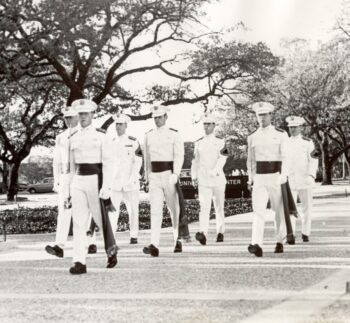Inside The Slow Pace Of Silver Taps

Eight Texas A&M students will be honored Sept. 5 at Texas A&M in fall’s first Silver Taps ceremony.
As the first Silver Taps of the school year, it will also be the very first time many new Texas A&M students experience this century-old tradition.
Following are descriptions from a former executive officer of the Ross Volunteers honor guard that may help new Aggies learn what to expect, though the emotion of the ceremony itself can only be experienced in person.
‘Perfect and in perfect silence’
Once the campus lights around the Academic Plaza are darkened at 10:15 p.m., time slows and voices hush. Students gather without talking, without taking pictures or video. Family members are offered seats at the center of the plaza.
At 10:30 p.m., slow steps can be heard as a special squad of Texas A&M’s Ross Volunteers enters the plaza, their distinctive white uniforms palely visible in the darkness.
Thus begins Silver Taps, held for over 100 years by Texas A&M students for their fellow students who have passed away.
“To be perfect and in perfect silence, that is the challenge,” said a former executive officer of the Ross Volunteers. “To get 21 people to take every step on time with each other is the beauty of the ceremony and the challenge.”
He and the other Ross Volunteers, as well as the buglers who play Silver Taps from the top of the Academic Building, do not identify themselves by name – a tradition that grew up after the 1960s to keep the focus of the ceremony on the Aggies being honored.
“The policy is not secrecy, but anonymity,” he said. “We don’t want a student to be standing there thinking, ‘That’s my friend doing that.’ We want the focus to be on the student and on the family.”
Before each Silver Taps, the RVs put in 3 to 5 hours’ practice.
“All the drill movements themselves are movements that RVs know how to do with a rifle,” he said. “It’s just the commands, the speed and the unison with which we do it” that make Silver Taps different.
The pace at which the RVs march for Silver Taps is “significantly” slower than their normal parade cadence. “It’s passed down, rather than measured. I don’t think I have written down anywhere the time between each step,” he said. “You keep in beat within your own head.”
This cadence is used only for Silver Taps. They don’t even use it at Muster, he said.
“Once we enter the plaza, then we go into Silver Taps cadence.”
The squad’s commander, who carries a saber, issues commands in near-silence. “Forward march, halt – all those things are not different, they’re just silent. It’s just done almost inaudibly.”
Proceeding to the center of the plaza, the squad stands at attention (marked by the sound of rifle butts touching the ground), at which point all Corps members in attendance also stand at attention.
Three rifle volleys and three renditions of ‘Taps’
The firing squad spaces out their ranks and executes a half-right face to get into position to fire. The commander orders the three rifle volleys – one squad at a time. After each volley, rifles are set back down.
High above and out of sight atop the Academic Building, six buglers play the slow, three-part arrangement of “Taps” created nearly a century ago by A&M band director Col. Richard Dunn. (Listen to a recording here.)
All cadets present salute throughout the three renditions of “Silver Taps.” Tradition says it is played once to the north, south and west, “but never to the east, because it is said the sun will never rise on that fallen Aggie again.”
When the buglers finish, the commander brings their saber back up, and all cadets present shift to parade rest.
The firing squad waits “for 21 bells from the clock tower, symbolic of the 21-gun salute.” Then they do a right-face, opposite the direction from which they entered the plaza, and march out at Silver Taps cadence.
When they reach the edge of the plaza, they switch to regular parade cadence. This signals the end of the ceremony.
Striving for perfection in the ceremony is their way of “showing that respect to the students and families,” he said.
Honoring the fallen and their families
Throughout the day of Silver Taps, the student Traditions Council offers the opportunity to write letters to the families of the students being honored.
Traditions Council hosts and escorts the family members for the ceremony.
The Ross Volunteers save the shell casings from the rifle volleys: “The blanks don’t discharge. We take them out when we’re back at the armories,” said the former executive officer.
“The shells are chromed and then given to the families along with some letters from the firing squad themselves.”
For fellow students, friends and family, the hope is that the ceremony offers honor and some measure of comfort. As Traditions Council puts it: “Although they’ve lost a family member, they still have an entire family here supporting them in Aggieland.”





